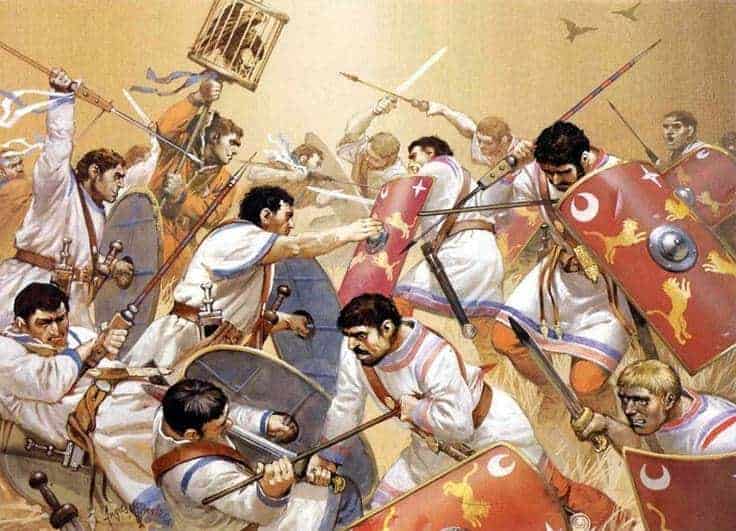Rome had just recovered from the Crisis of the Third Century thanks to the relatively strong and stable leadership of Diocletian; although Aurelian deserves an immense amount of credit. Diocletian first became Emperor of Rome in 284 and defeated Carinus to become sole ruler in 285. He quickly realized that the vast size of the empire meant it was almost impossible for one man to rule effectively alone. He made Maximian his co-emperor (Augustus) in 286.
Not content with dividing the empire in two, in 293, Diocletian appointed Constantius and Galerius as junior co-emperors. In doing so, he created a tetrarchy of four leaders; two senior Augusti and a pair of lower ranking ‘Caesars.’ It appeared to be a good idea, at least in the short-term, as it made the empire much easier to govern. However, human nature, and the previous history of Rome suggested that having so many rulers was a recipe for disaster, and so it proved.
Harmony reigned until Diocletian fell ill at some point in 304 while on a campaign against the Carpi. There were rumors of his death soon after as he was not seen in public for months. When he finally emerged in March 305, he was emaciated and barely recognizable. The ancient historian Lactantius suggests that Galerius forced Diocletian to stand down in May 305; he was the first Roman Emperor ever to abdicate voluntarily.
Most people expected Constantine, son of Constantius, and Maxentius, son of Maximian, to become Caesars. Instead, the titles went to Maximinus Daia (Galerius’ nephew) and Severus. Maximian also abdicated his throne and was replaced by Galerius, Constantius became the new co-emperor in place of Diocletian, and all hell was about to break loose.

1 – Maxentius the Usurper Grabs Power in Rome
Tensions were already bubbling under the surface, but perhaps disaster could have been averted had both new emperors reigned for as long as the previous duo. However, Constantius died just a year after becoming co-emperor (he ruled in the West) and was succeeded by Severus. This immediately caused a problem because Constantine was originally expected to be Caesar so when his father died; his troops rallied behind Constantine and declared him Augustus.
If matters were not complicated enough, Maxentius, also overlooked as a Caesar in 305, was unhappy at being left out of the equation. Emperor Galerius reluctantly bestowed the title ‘Caesar’ upon Constantine and sent him the purple robes of monarchy, which were readily accepted by Constantine as a symbol of his legitimacy. This caused Maxentius to act, and he declared himself Emperor of Rome in 306 in place of Severus.
Galerius was worried that this power grab would encourage others to come after his throne; so he ordered Severus to deal with the threat. Severus marched towards Rome with an army that was once led by the usurper’s father and former emperor, Maximian. The anxious Maxentius offered his father the position of co-emperor which the ex-leader gleefully accepted. Once Severus arrived in Rome, he was horrified to find that his men defected to their old commander. He fled to Ravenna to an untouchable position but foolishly believed Maxentius’ promise that he would spare his rival’s life if he surrendered.
Severus surrendered in March/April 307 but was immediately taken captive, imprisoned and eventually executed. After hearing the news, Galerius decided to march towards Rome himself and took a huge army with him. Remarkably, Maxentius was able to replicate what he did with Severus to a degree. A significant number of Galerius’ army defected after the promise of wealth and out of respect for Maximian. Galerius withdrew but angrily looted as much of Italy as he could along the way. By now, Maxentius had control of Italy and Africa and looked to consolidate power by making friends with Constantine.
Constantine married Maxentius’ daughter and received the co-emperor title from the senior ruler. Constantine was not willing to rise against Galerius. In April 308, Maximian attempted to depose his son but was shocked as the men remained behind the new ruler, so he fled to Constantine. Several of claimants to the throne called a conference at Carnuntum in 308 to try and salvage the situation. They begged Diocletian, who was in attendance, to return to power but the ex-emperor refused because he was happier farming cabbage than he was ruling an empire. He ordered Maximian to step down, decreed that Maxentius was no longer emperor and installed Licinius as the new leader.
The ‘compromise’ satisfied no one, and soon after the conference, all the claimants were at war against one another. Maximian had no intention of ‘retiring’ and rebelled against Constantine. He declared himself emperor by donning the imperial purple at the town of Arles and claiming that Constantine was dead. However, his attempts to bribe his new rival’s men failed, and soon, he left Arles. An irate Constantine returned from his campaign against the Franks to confront Maximian at Massilia. The luckless former Emperor was betrayed by the citizens of the city and stripped of his title. While Constantine showed clemency, he reportedly encouraged Maximian to commit suicide, and the three-time emperor did so in July 310 by hanging himself.

